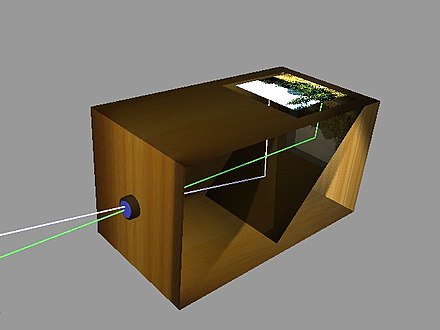Photography
Photography is the art, application, and practice of creating durable images by recording light, either electronically by means of an image sensor, or chemically by means of a light-sensitive material such as photographic film. It is employed in many fields of science, manufacturing (e.g., photolithography), and business, as well as its more direct uses for art, film and video production, recreational purposes, hobby, and mass communication.[1]
Typically, a lens is used to focus the light reflected or emitted from objects into a real image on the light-sensitive surface inside a camera during a timed exposure. With an electronic image sensor, this produces an electrical charge at each pixel, which is electronically processed and stored in a digital image file for subsequent display or processing. The result with photographic emulsion is an invisible latent image, which is later chemically "developed" into a visible image, either negative or positive, depending on the purpose of the photographic material and the method of processing. A negative image on film is traditionally used to photographically create a positive image on a paper base, known as a print, either by using an enlarger or by contact printing.
The word "photography" was created from the Greek roots φωτός (phōtós), genitive of φῶς (phōs), "light"[2] and γραφή (graphé) "representation by means of lines" or "drawing",[3] together meaning "drawing with light".[4]
Several people may have coined the same new term from these roots independently. Hercules Florence, a French painter and inventor living in Campinas, Brazil, used the French form of the word, photographie, in private notes which a Brazilian historian believes were written in 1834.[5] This claim is widely reported but is not yet largely recognized internationally. The first use of the word by the Franco-Brazilian inventor became widely known after the research of Boris Kossoy in 1980.[6]
The German newspaper Vossische Zeitung of 25 February 1839 contained an article entitled Photographie, discussing several priority claims – especially Henry Fox Talbot's – regarding Daguerre's claim of invention.[7] The article is the earliest known occurrence of the word in public print.[8] It was signed "J.M.", believed to have been Berlin astronomer Johann von Maedler.[9] The astronomer Sir John Herschel is also credited with coining the word, independent of Talbot, in 1839.[10]
The inventors Nicéphore Niépce, Henry Fox Talbot, and Louis Daguerre seem not to have known or used the word "photography", but referred to their processes as "Heliography" (Niépce), "Photogenic Drawing"/"Talbotype"/"Calotype" (Talbot), and "Daguerreotype" (Daguerre).[9]

A camera obscura used for drawing

Earliest known surviving heliographic engraving, 1825, printed from a metal plate made by
Nicéphore Niépce.
[28] The plate was exposed under an ordinary engraving and copied it by photographic means. This was a step towards the first permanent photograph taken with a camera.
View from the Window at Le Gras, 1826 or 1827, the earliest surviving camera photograph. Original plate (left) and colorized reoriented enhancement (right).
View of the Predikherenlei en Predikherenbrug in Ghent, October 1839, collection STAM - Ghent City Museum
View of the Boulevard du Temple, a daguerreotype made by Louis Daguerre in 1838, is generally accepted as the earliest photograph to include people. It is a view of a busy street, but because the exposure lasted for several minutes the moving traffic left no trace. Only the two men near the bottom left corner, one of them apparently having his boots polished by the other, remained in one place long enough to be visible.
A latticed window in Lacock Abbey, England, photographed by William Fox Talbot in 1835. Shown here in positive form, this may be the oldest extant photographic negative made in a camera.
Wilson Chinn, a branded slave from Louisiana--per The New York Times, "one of the earliest and most dramatic examples of how the newborn medium of photography could change the course of history."
[34] Advertisement for Campbell's Photograph Gallery from The Macon City Directory, circa 1877.
Undeveloped Arista black-and-white film, ISO 125/22°
A photographic darkroom with safelight
The first color photograph made by the three-color method suggested by James Clerk Maxwell in 1855, taken in 1861 by Thomas Sutton. The subject is a colored, tartan patterned ribbon.
Color photography was possible long before Kodachrome, as this 1903 portrait by Sarah Angelina Acland demonstrates, but in its earliest years, the need for special equipment, long exposures, and complicated printing processes made it extremely rare.
Kodak DCS 100, based on a Nikon F3 body with Digital Storage Unit
Photography on a smartphone
Angles such as vertical, horizontal, or as pictured here diagonal are considered important photographic techniques
An example of a dualphoto using a smartphone based app
This image of the rings of Saturn is an example of the application of ultraviolet photography in astronomy
Devices other than cameras can be used to record images. Trichome of
Arabidopsis thaliana seen via scanning electron microscope. Note that image has been edited by adding colors to clarify structure or to add an aesthetic effect. Heiti Paves from Tallinn University of Technology.
Example of a studio-made food photograph.
Classic Alfred Stieglitz photograph,
The Steerage shows unique aesthetic of black-and-white photos.
Josef H. Neumann:
Gustav I (1976)
National Guardsman in Washington D.C. (2021)
Wootton bridge collapse in 1861
Photography may be used both to capture reality and to produce a work of art. While photo manipulation was often frowned upon at first, it was eventually used to great extent to produce artistic effects.
Nude composition 19 from 1988 by Jaan Künnap.
The Musée de l'Élysée, founded in 1985 in Lausanne, was the first photography museum in Europe.

